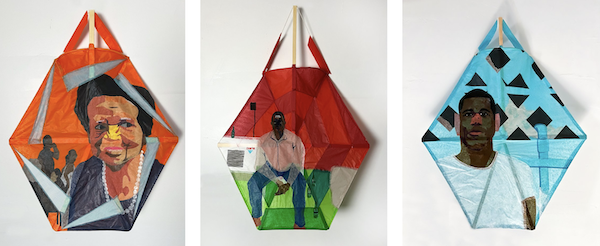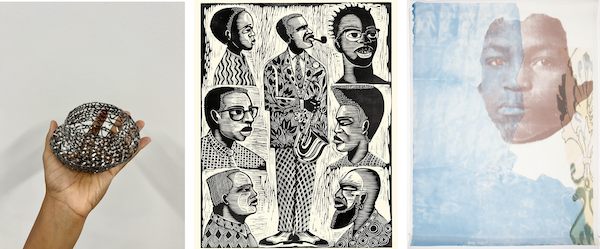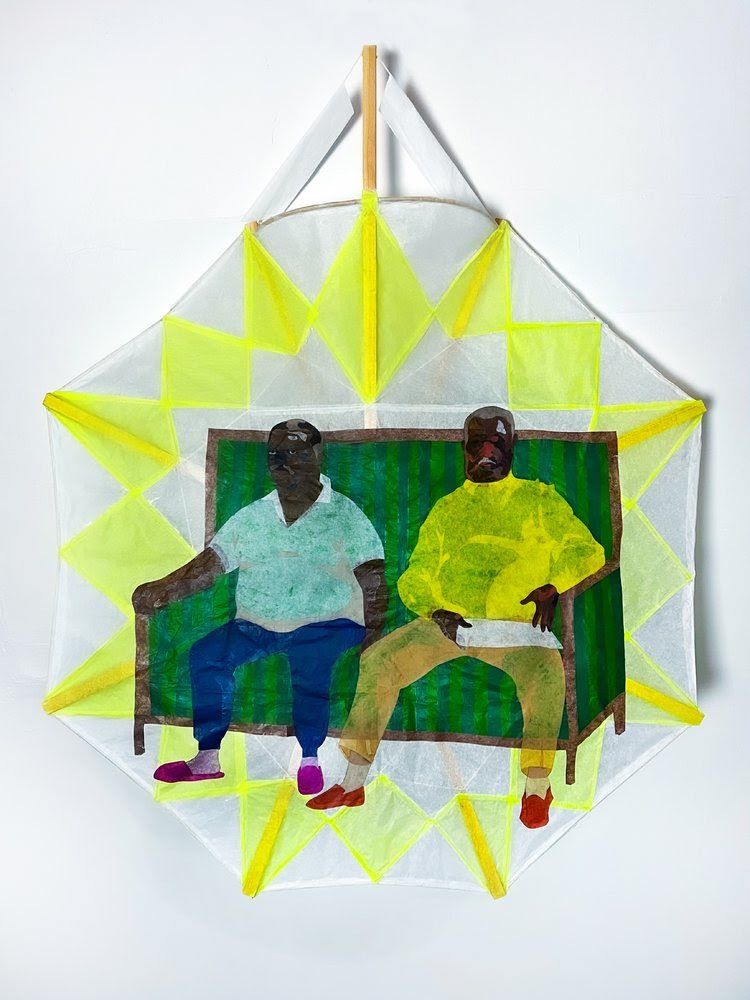White Kite by Jordan Carey, tissue paper & wood, 30″ x 24″, 2022
A kite is not always just a kite; sometimes it is a statement of identity.
“Bermuda has a tradition of making kites,” says Jordan Carey, an artist who now lives in Portland, Maine, though born and raised on the island. “Bermudians make kites in the spring, and fly them on Good Friday. It’s an island custom for children and families.”
For Jordan, kite-making is one of the few untainted markers of cultural identity left to him from his home island.
“Bermuda was historically a tourism-based economy, and so much of our heritage has been co-opted for that. The Gombey is a great example. It’s a folk performance that blends the island’s African and Native American roots, and now it’s become much more of a show for entertainment purposes. It’s the kite-making the local people have held onto as a thread of Bermudian culture not so bound up in colonial capitalism. It’s kites that connect me to my childhood.”
So Jordan has made kites into emblems of personal identity. Into art.
And they are beautiful.
Delicate and lightweight, colorful as butterfly wings, Jordan’s kites are a balance of homespun craft and artistic expertise. Using only colored tissue as his medium, he illustrates the kites with portraits of family members. They are shown at ease, seated or standing, always surrounded by bright geometric patterns. There is a cozy, quietly joyous sensibility to his scenes, each a tender vignette created from love of person and place. The whole is all the more poignant when experienced as works of art on the walls of a gallery in Maine: like lightning bugs in a jar, these characters’ essences shine, even this far from home.

Left to right, all works by Jordan Carey, tissue paper & wood, 2022: Orange Kite, 24″ x 18″; Red Kite, 24″ x 21″; Blue Kite, 30″ x 24″
The kites were included in Stay Black & Die, a recent exhibition at Cove Street Arts in Portland which Jordan curated.
“I had the idea for the exhibition as a student [at Maine College of Art & Design (MECA&D)] because I was thinking so much about Black ephemerality and creative practices. I wanted to explore Black Diaspora experiences, and an exhibition seemed the right way to do that.”
True to his intentions, Jordan’s exhibition includes works covering a range of narratives and experiences, all linked by their ties to Black and Brown identity and experience: Daniel Minter, whose woodcuts portray emblems of Black style and fashion (haircuts and combs; suits and shoes); Aminata Conteh, a first-generation American of Sierra Leonean heritage whose hybrid work combines techniques of metalsmithing, jewelry, weaving, and basketry bearing (according to the artist) “the weight of memories, breath, and people”; Kyle b. Co., a trans-disciplinary artist whose screen prints are driven by the artist’s need to address “Black and queer histories of survival and existence.”

Left to right: Aminata Conteh, This Is Not the Water of My People; Daniel Minter, We Cut Heads; Kyle b. Co., Queer in the B(l)ack
Jordan assembled these and other artists into a cohort of individuals steeped in a legacy of exile, centered by his exhibition.
It is a consistent element in his work: championing those more familiar with the margins than the limelight, valuing the under-appreciated and those often unseen. His work is restorative, steeped in a social justice mindset.
Nowhere is this more apparent than at Loquat, a downtown Portland retail shop Jordan considers an extension of his art practice. Originally conceived as his senior thesis project in 2019 when Jordan was a Textile & Fashion Design major at MECA&D, Loquat has flourished, selling objects and brands by and for a variety of artists and designers representing marginalized experiences. It’s also a community hub, advancing diverse cultural identities with projects such as Roots & Culture, and public programs at the store itself.
Through his art, Jordan seeks to have real-world impact. As a college student, he determined a more conventional “fine arts” path could not on its own effectively meet his goals. The scaled-up commercialism offered by Loquat became another avenue, different from and as valid as any curated exhibition or homespun craft.
Jordan’s blend of commercial enterprise, curatorial exploration, and making art is a variegated practice, one refusing easy categorization. His approach to creativity does not privilege any one artistic identity over another. Each has its place, its unique attributes, its role in the ecosystem of his practice.
“As an artist, I want to stimulate a certain strain of thought or instigate something emotional. I want to be as effective as possible, using whatever it takes to serve my goal.”
Even kites.
Born and raised in Bermuda, Jordan Carey is a textile design and fashion artist based in Portland, Maine.

